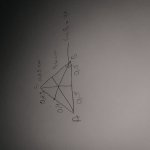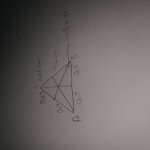Is there a difference of unit between dimensionless measure of angles and length in triangles? For example two sides are composed of a distance of \(\displaystyle 0.85cm+0.4cm=1.25cm\) and at the same time \(\displaystyle 0.4cm=\cos\theta\) , where the altitude is situated on one of side of the triangle, and the base is \(\displaystyle 1cm\)?
For consecutive number or non consecutive numbers \(\displaystyle x<y<z\) I have the following answer:
\(\displaystyle (((\frac{\sqrt\frac{y}{z}}{(1-\frac{x}{z})\times\sqrt\frac{x+z}{z-x}})\times\frac{x}{z})+\sqrt\frac{z-y}{z})\times((1-\frac{x}{z})\times\sqrt\frac{(x+z)}{(z-x)})=\sin A\)
\(\displaystyle (\frac{\sqrt\frac{y}{z}}{(1-\frac{x}{z})\times\sqrt\frac{x+z}{z-x}})-(((\frac{\sqrt\frac{y}{z}}{(1-\frac{x}{z})\times\sqrt\frac{x+z}{z-x}})\times\frac{x}{z})+\sqrt\frac{z-y}{z})\times(\frac{x}{z})=\cos A\)
\(\displaystyle \sqrt\frac{(z-y)}{z}=\cos B\)
\(\displaystyle \sqrt\frac{y}{z}=\sin B\)
\(\displaystyle \frac{x}{z}=\cos C\)
\(\displaystyle ((1-\frac{x}{z})\times\sqrt\frac{(z+x)}{(z-x)})=\sin C\)
\(\displaystyle (\sqrt{\frac{y}{z}}\times\frac{x}{z})+\sqrt\frac{z-y}{z}\times((1-\frac{x}{z})\times\sqrt\frac{(z+x)}{(z-x)})=\sin A\)
\(\displaystyle (-\sqrt{\frac{z-y}{z}})\times\frac{x}{z}+\sqrt{\frac{y}{z}}\times((1-\frac{x}{z})\times\sqrt\frac{(z+x)}{(z-x)})=\cos A\)
The following variables \(\displaystyle a,b,c\) represent the length of the sides of the triangles.The angles have no unit but the lengths do.
\(\displaystyle \frac{\sin A}{\sin C}=a\)
\(\displaystyle \frac{\sin B}{\sin C}=b\)
$\frac{\sin C}{\sin C}=c[/tex]
h=altitude
\(\displaystyle \frac{h_c}{h_a}=a\)
\(\displaystyle \frac{h_c}{h_b}=b\)
\(\displaystyle \frac{h_c}{h_c}=c\)
\(\displaystyle ((((\frac{\sin B}{\sin C})\times\cos C)+\cos B)\times\sin C)=\sin A\)
\(\displaystyle (\frac{\sin B}{\sin C})-((((\frac{\sin B}{\sin C})\times\cos C)+\cos B)\times\cos C)=\cos A\)
\(\displaystyle ((((\frac{\sin A}{\sin C})\times\cos C)+\cos A)\times\sin C)=\sin B\)
\(\displaystyle (\frac{\sin A}{\sin C})-((((\frac{\sin A}{\sin C})\times\cos C)+\cos A)\times\cos C)=\cos B\)
And you can obtain all six theta of trigonometric functions \(\displaystyle \sin\theta\) and \(\displaystyle \cos\theta\) with consecutive or non consecutive numbers, where \(\displaystyle x<y<z\)
For consecutive number or non consecutive numbers \(\displaystyle x<y<z\) I have the following answer:
\(\displaystyle (((\frac{\sqrt\frac{y}{z}}{(1-\frac{x}{z})\times\sqrt\frac{x+z}{z-x}})\times\frac{x}{z})+\sqrt\frac{z-y}{z})\times((1-\frac{x}{z})\times\sqrt\frac{(x+z)}{(z-x)})=\sin A\)
\(\displaystyle (\frac{\sqrt\frac{y}{z}}{(1-\frac{x}{z})\times\sqrt\frac{x+z}{z-x}})-(((\frac{\sqrt\frac{y}{z}}{(1-\frac{x}{z})\times\sqrt\frac{x+z}{z-x}})\times\frac{x}{z})+\sqrt\frac{z-y}{z})\times(\frac{x}{z})=\cos A\)
\(\displaystyle \sqrt\frac{(z-y)}{z}=\cos B\)
\(\displaystyle \sqrt\frac{y}{z}=\sin B\)
\(\displaystyle \frac{x}{z}=\cos C\)
\(\displaystyle ((1-\frac{x}{z})\times\sqrt\frac{(z+x)}{(z-x)})=\sin C\)
\(\displaystyle (\sqrt{\frac{y}{z}}\times\frac{x}{z})+\sqrt\frac{z-y}{z}\times((1-\frac{x}{z})\times\sqrt\frac{(z+x)}{(z-x)})=\sin A\)
\(\displaystyle (-\sqrt{\frac{z-y}{z}})\times\frac{x}{z}+\sqrt{\frac{y}{z}}\times((1-\frac{x}{z})\times\sqrt\frac{(z+x)}{(z-x)})=\cos A\)
The following variables \(\displaystyle a,b,c\) represent the length of the sides of the triangles.The angles have no unit but the lengths do.
\(\displaystyle \frac{\sin A}{\sin C}=a\)
\(\displaystyle \frac{\sin B}{\sin C}=b\)
$\frac{\sin C}{\sin C}=c[/tex]
h=altitude
\(\displaystyle \frac{h_c}{h_a}=a\)
\(\displaystyle \frac{h_c}{h_b}=b\)
\(\displaystyle \frac{h_c}{h_c}=c\)
\(\displaystyle ((((\frac{\sin B}{\sin C})\times\cos C)+\cos B)\times\sin C)=\sin A\)
\(\displaystyle (\frac{\sin B}{\sin C})-((((\frac{\sin B}{\sin C})\times\cos C)+\cos B)\times\cos C)=\cos A\)
\(\displaystyle ((((\frac{\sin A}{\sin C})\times\cos C)+\cos A)\times\sin C)=\sin B\)
\(\displaystyle (\frac{\sin A}{\sin C})-((((\frac{\sin A}{\sin C})\times\cos C)+\cos A)\times\cos C)=\cos B\)
And you can obtain all six theta of trigonometric functions \(\displaystyle \sin\theta\) and \(\displaystyle \cos\theta\) with consecutive or non consecutive numbers, where \(\displaystyle x<y<z\)
Last edited by a moderator:


